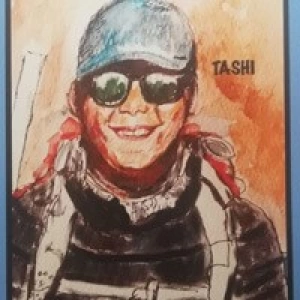This expedition is not only an introduction to high altitude mountaineering, it is a wonderland of nature and breathtaking scenes of the Himalayas. The route follows the route of the Mera Peak expedition, but after descending from its summit to the Mera La pass the trail branches we head north-east into the mountain wilderness of the Upper Hongu Valley. Mount Lhotse and Everest are visible directly in front of us as we follow the valley along the towering rock face of Chamlang until we reach the sacred lakes at Panch Pokhri. Next we face the Amphu Labsta pass, 5700m, a tough technical crossing, and descend into the Imja Valley, where we will set up a base camp and prepare to summit Island Peak, 6189m, which lies close to the imposing south face of Lhotse. After the summit we descend the Everest Trail stopping in the Sherpa capital of Namche Bazaar before completing the circuit trek at Lukla.
Who should do the Mera Peak, Amphu Labtsa and Island Peak expedition?
Although this expedition has some very easy and basic trails, the trek is graded Alpine Grade C2 because the schedule includes five continuous nights over 5100meters in very remote locations and because of two 6100m peaks. There are good trails for most of the route, including a well-marked trail in the snow leading over the Mera La. The paths in the upper Hongu Valley are less used but the underfoot conditions are still relatively easy.
The first few days trail between Lukla and Tagnag passes through delightful rhododendron and pine forests, whilst higher up beyond Kothay, there is no vegetation.
Annapurna Foothills Treks and Expedition provides you with Sherpas and porters who are well experienced and well equipped for the high altitude who will be able to assure your safe execution of the expedition.
There is little chance of buying supplies on the way: all trekkers should be well prepared with the personal effects they require during the trek.
Climbing difficulty:
Mera Peak: The normal route by the north face to the summit of Mera Peak, is not technically difficult. It is rarely steeper than 30 degrees, except for the final 30-40m climb to the summit where fixed lines are used for safety. Ski sticks are useful in soft snowy conditions and a single walking axe for hard snow and ice. Although any climbing at these altitudes is strenuous and exhausting, the route is carefully designed to allow for your acclimatization. Stopping for two nights and one day at high camp, 5800m, will give you the best possible chance of reaching the summit.
Amphu Labtsa pass: This is more technical than Mera Peak. It will be necessary to surmount a series of ice steps (using a fixed line for safety) to reach the rocky crest, and from the summit you will use a figure 8 to make a 35m abseil to where you will reach the fixed lines for the remaining 300m descent of over 30 - 40 degrees in snow and rock until you reach easier slopes.
Island Peak: This Mountain is technically more demanding than Mera Peak. Though lower in altitude it involves climbing 45 degree snow covered slopes and the summit ridge is completely exposed. Fixed lines are used on all exposed sections but rope climbing skills are required; for this reason our experienced guides will give you a thorough training during the climb of Mera Peak and again before the summit of Island Peak.
Then there are the five sacred lakes in front of us and we have reached one of the most fantastic places of the earth: the Panch Pokhris at the foot of the impressive Baruntse, 7.168 m high.
It is very quiet. Up here, many gods of the Himalayas have their throne. No wonder people believe this, with all of the beauty, that one experiences here high above.
Quick Review:
After completing Mera, Amphu Labtsa Pass and Island Peak trip i feel it's only right that i write a review of my experience with Annapurna Foothills Treks.
I initially chose this company because of the price and they were much cheaper than the UK companies that offer a similar trek and by bypassing the middle man this will always bring the price down to a reasonable level...after completing the trek i feel the number of days offered is perfectly adequate to enjoy this demanding circuit and don't underestimate how tough it can be, but if you fancy a challenge and experience high altitude walking with some climbing throw in then this is the trek for you .The climbing guide Chhongba couldn't seem to do enough for us and constantly made sure we were fed and watered and comfortable ... the porters worked tirelessly to carry our kit and supplies and setup camp when necessary
Again, using a company i didn't know was a risk but in fact, Annapurna Foothills turned out better than expected and i'm so chuffed i used them
Thanks again Ngima, Chhongba and all the porters for a great and enjoyable trip
Colin Roxborough
Lymington, Hants, UK
ps if anyone would like additional info or would like see my pictures then email me
[email protected]

